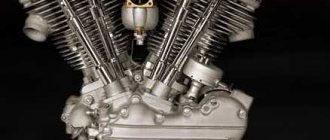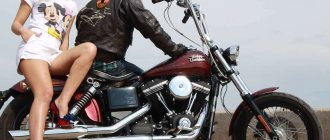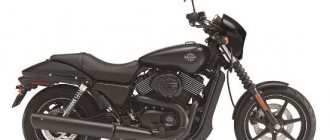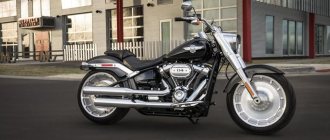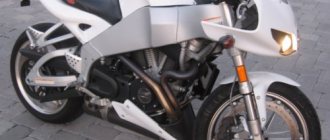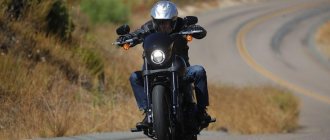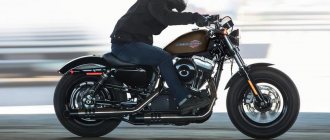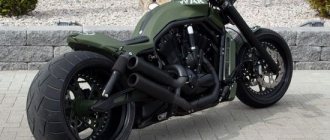motorcycle strangers
In the product line there are three main groups of models, united by engine type: XL- Sportster V - VRSC F - Big Twin
T.o. the first letter (or 2 for the sportster series) indicates membership in the family.
Based on these groups, there are five families of motorcycles:
XL-Experimental Lightweight (1, 2 letters) C-Custom (3 letter) R-Roadster (3 letter) L-Low (3 letter) N-Nightster (3 letter)
F-Big Twin (1 letter) X-front wheel 19 or 21 inches, footpegs D-DYNA C-Custom X-Sport L-Low WG-Wide Glide B-Street Bob F-Fat Bob
F-Big Twin (1 letter) X-front wheel 19 or 21 inches, thin fork stays, footpegs L-front wheel 16 inches, Touring style fork (thick stays), footpads ST-Softail B-Night Train F- Fat Boy N-Deluxe D-Deuce SC-Springer Classic C-Custom / Classic SB-Cross Bones CW-Rocker
F-Big Twin (1 letter) L-16-inch front wheel, Touring-style fork (thick stays), footrests H-Tourer(Highway) R-Road King P-Police T-Tour Pack S-Custom C-Classic U-Ultra A-ABS K-Limited ('10 model)
The 3rd and 4th letters are used as the model designation, i.e.: HR - Road King HT - Electra Glide HS - Street Glide (up to '92 - Electra Glide Sport) TR - Road Glide, until 1987 Tour Glide
VRSC 1130 or 1250 cm³
VV-Twin R-Racing S-Street C-Custom AA Series R-Roadster D-Dragster W-Wide Tire X-Special
I - electronic fuel injection system (indicated before 2006, if there were carburetor models in the model range) A - ABS system SE - limited edition in the Screamin' Eagle version
Add a comment Cancel reply
You must be logged in to post a comment.
This site uses Akismet to reduce spam. Find out how your comment data is processed.
Source
ShovelHead [ ]
Shovelhead. Produced from 1966 to 1984, it replaced the PanHead and was subsequently replaced by the Evo. From 1966 to 1978 the engine capacity was 73.66″ 1200 cm3, the 1978-1984 modification had a volume of 82″ or 1340 cm3. Early ShowelHeads are very similar to PanHeads because they are based on a similar base. Since 1969, the similarity has been lost. The most unreliable engine. Black streak - it was at this time that Harley was under the control of the AMA. It was at this time that reliability problems began. It is from this time that Harley cannot “wash off” the stereotypes - it is unreliable, breaks down, pisses on oil, etc.
Harley Davidson WLA-42 - The legendary “Soviet” motorcycle
Harley is the dream of every motorcyclist, because it is the leader in the motorcycle industry.
Interesting fact: in the post-war period in the USSR, in order to become a happy owner of a Harley, it was enough to enroll in the Soviet army and be in line to receive the legendary motorcycle.
Historical fact
The fact is that when the second front opened, the Americans simply flooded the USSR with special-purpose equipment. Many Harley Davidson WLA-42 cars were also delivered from the USA and Canada.
This motorcycle was called the liberator. In battles it was characterized by power and reliability. A stroller was attached to it, from either side, and a Degterev DP-27 machine gun was already attached to it. The motorcycle behaved perfectly in the mud and cold, working flawlessly. The stroller significantly increased the volume of transported cargo.
Appearance and comfort
The motorcycle itself is quite heavy (220 kg), but this did not affect the handling. The motorcyclist's position is peculiar, the back is straight, the knees are bent at 90 degrees, as if swallowed by a stake. But the most difficult thing is the control, the gear shift mechanism is manual, and the clutch is operated by foot. The controls are similar to driving a car, it takes some getting used to.
There is simply no rear suspension, but this does not affect ride comfort. In general, when driving this device, you feel like a respectable person.
Motorcycle engine
The WLA-42 engine was in production from 1930 to 1948. A special feature of the engine was flat heads with fins. The engine is four-stroke with two V-shaped cylinders located side by side, carburetor. Fuel consumption on level terrain in compliance with the speed limit is 5 liters per 100 km. path, under difficult conditions and full load, consumption increased to 11 liters. Battery-type ignition using a six-volt battery.
- All its advantages were appreciated by scouts and signalmen, and officers also loved this motorcycle. For signalmen, an additional trunk was installed in the back to transport reels of wires; the transported weight reached 100 kg. The scouts estimated the speed developed by the motorcycle; on flat terrain it reached 115 km. h., at that time it was an unimaginable speed, and the escape on one gas station was up to 190 km. Officers fell in love with the motorcycle simply for its riding comfort.
- About 80,000 thousand were produced in America, and about 50,000 thousand WLA-42 motorcycles were imported to the USSR. Many motorcycles were destroyed in battles, but due to the fact that many spare parts and components were imported, the motorcycles were repaired.
- In the post-war years, the use of the WLA-42 was gradually replaced by the domestic Ural motorcycle, the production of which was gaining momentum. In 1940, the Irbit motorcycle plant produced the first motorcycle IZM M-72, a complete copy of the German BMV R-71. Subsequently, the modernization of the M72 was renamed Ural. But the legendary Harley Davidson WLA-42 has taken root in the hands of amateur collectors and is still working properly.
Video
Test drive Harley Davidson WLA-42
And in conclusion
There is even one story. After the war, returning home to his native northern village, the signal officer brought a gift from his American colleagues, a Harley Davidson WLA-42. A special feature of the motorcycle was the inscriptions in English and the license plate belonging to the American part. The owner of the motorcycle built a double wall in the barn and hid a dear gift from the special. services since the Cold War began. The legend was discovered by the officer’s relatives, who discovered a double wall when dismantling the barn. The motorcycle has been preserved in perfect working condition and original equipment!
BlockHead - Evo [ ]
Evolution. Produced from 1983 to 1999, it replaced the ShowelHead and was subsequently replaced by the TwinCam. Engine capacity 80″ or 1340 cm3. From a distance it looks very similar to TwinCam. You can distinguish them by the “Timing Cover” on the right, the Evo has two rivets vertically, and the cylinder head covers – the Evo has THREE parts. For the first time, fuel injection (injector) was used on this engine in 1996.
There are no longer any problems with reliability, the company has returned back to the Harley-Davidson family, the quality is at the same level.
History of Harley-Davidson Twin Cam engines, part 1.
In the last post, a reasonable question was asked in the comments: if Evo engines were as cool as they say, then why were they abandoned?
I won’t tell you for the whole of Odessa, the whole of Milwaukee, but in addition to the conspiracy theory of manufacturers who need to get as much money out of the consumer’s pocket as possible, there were more objective reasons: competition with Japanese and European manufacturers, who at that time were already producing larger and more powerful engines ; the need to comply with stricter environmental requirements and noise standards, etc. In addition, Harley owners themselves often modified their Evos in pursuit of more power, i.e. there was obviously a need for it. And the Evo engines were not as ideal as we would like: they had problems with lubrication, oil leakage, and others.
However, I will not start the eternal dispute between “old schoolers” who like to rebuild engines on their own in their garage (for which they especially loved the Evo - for the ease of assembly and disassembly) and “fake” motorcyclists who prefer only to ride and send the “sleds” to be repaired for service. To each his own! So let's go back to history.
Already in 1992, there was a need to increase engine power: Harley-Davidson saw what tuning companies and individual users were doing in this area. Work began on a new engine code R-22, which later became the Twin Cam. It was a new engine, made in the old tradition: a 45-degree overhead valve V-twin with air cooling.
HD Electra Glide Classic 1999
The new engine was initially designed for further modernization: with a larger distance between the centering pins (which made it possible to increase the engine volume by increasing the diameter of the cylinders), with bearings designed for greater loads, and with a reinforced crankcase.
On December 2, 1993, the first engine of the new Twin Cam 88 series (1450 cc), also known as Fathead, was launched for the first time.
HD Convertible 2000
Conceptually, it was a new “bottom” with a modernized “top” from Evolution: with an increased cylinder diameter, reduced piston stroke and valve drive from two camshafts located below.
Initially, the premiere of the new engine was scheduled for 1997, but during testing problems arose with oil circulation: it leaked through all the cracks and the breather. The prototype spent many hours with special glass windows on the dyno so that engineers could see the oil paths inside. It turned out that the junction box was not draining properly. It was then decided to isolate it from the crankcase using a dual oil pump system built into the engine rather than the external pump that had been used in older Big Twins since the days of Knucklehead.
How to Determine Harley Engine Size
Over the years, Harley-Davidson has produced a range of engines for its classic-style motorcycles, from the original 25cc single-cylinder engine to the original 25cc single-cylinder engine. inches, built in 1903, to a powerful 103 cc Twin Cam V-twin engine. all Harley Big-Twin models released in 2012. Determine your motorcycle's engine displacement—or engine size—using engine bore and stroke specifications, vehicle and motorcycle engine identification numbers, or simply visual identification of the engine itself.
Bore and stroke characteristics
The most accurate method of determining a Harley-Davidson's overall displacement in cubic inches is to use the engine's bore and stroke specifications; however, this can only be done if you can obtain these specifications through a service manual, magazine review, or specification provided by an engine tuner. Bore and stroke refer to the inner diameter of the engine's combustion chamber in the cylinder head, and the distance between the piston moves from top dead center to top dead center in one stroke respectively. The formula used to determine engine displacement is: B × B × p/4 × S × N = Displacement. In this case, B will be equal to the inner diameter, p/4 will be equal to pi - 3.14 - divided by four, S will be equal to the stroke, and N will be the number of engine cylinders. As an example, let's take a typical Twin-Cam 88 engine that was used between 1998 and 2006. The TC88 had a 3.75-inch bore and 4-inch stroke. Using the formula above, it would look like this: 3.75 inches x 3.75 inches x 0.785 x 4.00 inches x 2 cylinders = 88.3 cubic inches. Likewise, the new TC96 engine has an identical bore but a longer stroke of 4.38 inches. This results in a displacement of 96.7 cubic inches using the same formula. This formula is an extremely accurate method that can be useful in determining the displacement of a modified high-performance engine, but is equally applicable to production engines.
Visual identification
Harley-Davidson engines are well known for their appearance, many of which are named after the shape of the cylinder heads or other engine components. These design elements can help you determine the bias of a particular motor; however, some motor types were available in a range of displacements, making it difficult to determine the exact motor size using visual cues alone. For example, the 45 cu in Flathead engine, manufactured between 1929 and 1947, had flat-top cylinder heads and placed its valves along the sides of the cylinders. Likewise, the 1966-1984 Shovelhead engine was identified by its spade-shaped cylinder box covers. Determining the exact displacement for any given engine often comes down to being able to decipher the engine number or determine the type of motorcycle it belonged to. However, newer Twin-Cam engines often have a sticker on the timing cover on the right side of the crankcase indicating the engine type.
Vehicle and engine identification numbers
Almost all Harley-Davidson motorcycles created have some sort of identification number printed on the engine, frame, or both, which allows technicians to quickly identify the motorcycle model and engine type. Unfortunately, old Harley-Davidson VIN numbers have changed constantly over the years, making early engine models difficult to identify. Between 1929 and 1968, Harley-Davidson used up to four Big-Twin engines, starting with the Flathead, Knucklehead, Panhead and Shovelhead engines. Engines manufactured before 1969 typically use a 10- or 11-digit identification number, starting with a two-digit production date, followed by a two- or four-digit model type and a four- or five-digit production run number. Using the model type as a guide, you can determine the size of the engine that the motorcycle was equipped with. Shovel engines manufactured between 1970 and 1980 were available in 74 or 80 cubic inch displacement and used a coding system similar to previous engine types. However, the model type is indicated by the first two characters, and the next five digits indicate the production run, followed by a two-digit model year identifier. It should be noted that 80 cubic inch engines were only available after 1978. All engines built after 1980, including 74 and 80 cubic inch Evolution Big-Twin engines, 883 cubic inch Sportster engines. cm and 1200 cc CM and Twin Cam 88 Engines 96 and 103 follow the same method as the Shovelhead engine codes.
Current engine types
The current Harley-Davidson motorcycle model uses three types of engines in its line of motorcycles: Twin Cam, Evolution, and Revolution engines. Engine displacement is fairly consistent across all of these engines, making it easier to determine engine size by identifying the motorcycle model and year. The Twin-Cam 88 engine has been found in most Harley-Davidson motorcycles since 1998, with the exception of the Evolution-powered Sportster models. The Evolution engine was available with 883 or 1200 cc displacement. cm - 45 and 74 cubic inches respectively - for the Sportster series. The Twin Cam engine was increased to 96 cubic inches in 2007, followed by a subsequent increase to 103 cubic inches for most of the 2012 model year. The final engine type, the 69-cubic-inch Revolution, was introduced in 2001 to power Harley-Davidson's radically different V-Rod VRSC. Harley's only liquid-cooled engine remained unchanged until 2012, as found only in the V-Rod family.
Related articles:
- How to calculate CC on a motorcycle engine
- Harley-Davidson Evolution Engine Specifications
- Harley Davidson 1450CC Engine Specifications
- 1995 454 Engine Specs
- Harley Panhead Specifications
- Technical characteristics of the CVO 110 engine
Harley-Davidson → Decoding HD model codes
For a long time I wanted to understand the letter codes that HD uses to designate its models. The question of how they are correctly deciphered has baffled even an official dealer employee. Therefore, it was decided to google it properly and try to compile a transcript on our own.
I would be grateful for the community’s help in clarifying and correcting possible errors. If you know other abbreviations, write, we will add and clarify the list!
First letter
Indicates engine model G - Trike with a large trunk, produced from 1932 to 1972. E - Overhead valve "big twin" with a volume of 61 "cc. (separate engine and transmission) F - Overhead valve “big twin” with a volume of 74.80 ″ cu. or 88″ cu. FL – Engine capacity from 80″ cc. up to 88″ cu. with a wide front tire K - Side-valve engine with a displacement of 45"2 and 55"2. A sports version that replaced the WL model in 1953. In 1957 it was replaced by the Sportster, which inherited many of the features of the K-series. U - “Big twin” with side valves with a volume of 74 ″ cubic. or 80″ cu. V – 74″ cc side valve engine. The model was produced until 1936. W - Side-valve engine with a capacity of 45″ cc. The model was produced from 1934 to 1952. X - “Sports” or “special” engine design. Used from 1918 to 1922 on the Sport flat-two model, in 1944 on the military version and from 1957 to the present on Sportster models.
Harley Davidson V Rod specifications and review
Harley Davidson is a motorcycle manufacturer that is known both to the biggest fans of two-wheeled vehicles and to people who have never sat on the seat of a real bike. This brand has existed for more than a hundred years, and during this time it has produced a large number of legendary motorcycle models. One of them is the Harley Davidson V Rod. It is this bike that will be discussed in our review.
